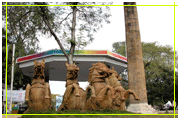

- Rajasthan
- Kerala
- Maharastra
- Tamilnadu



 City : Nagpur
City : NagpurLocation : West India
Language : Marathi, Hindi
About Nagpur
Nagpur, the center of India identified with a milestone showing Zero, is a vibrant town located in the state of Maharashtra located at its north eastern parts. Nagpur literally means the abode of serpent God Nag and is also known as Orange city with its famous variety of oranges. Nagpur is the trade centre for the high quality delicious oranges grown in the city and its outskirts. The present day city was founded by Bhakt Buland, an erstwhile prince of the region in 18th century.
Nagpur breasts many important tourist attractions. Pench National Park, the mammoth stupa at Deeksha Bhoomi and the temple of Sri Podeshwar Ram are some of the important attractions. Historically Nagpur has been renowned for its hospitality. Nagpur attracts thousands of tourists to its lap with versatile lakes, picturesque gardens, lusting green forests and luxurious amnesties for the privileged travelers.
Nagpur breasts many important tourist attractions. Pench National Park, the mammoth stupa at Deeksha Bhoomi and the temple of Sri Podeshwar Ram are some of the important attractions. Historically Nagpur has been renowned for its hospitality. Nagpur attracts thousands of tourists to its lap with versatile lakes, picturesque gardens, lusting green forests and luxurious amnesties for the privileged travelers.
History
Human existence around present day Nagpur city can be traced back 3000 years to 8th century BC. Menhir burial sites at Drugdhamna(near Mhada colony) indicate megalithic culture existed around Nagpur and is still followed in present times. The first reference to the name Nagpur is found in a 10th century copper-plate inscription discovered at Devali in the neighbouring Wardha district.
The inscription is a record of grant of a village situated in the visaya (district) of Nagpura-Nandivardhana during time of Rastrakuta king Krsna III in the Saka year 862 (940 CE). Inscription found at Ramtek show that during the 12th century AD Nagpur and its surrounding regions formed the part of the thickly wooded country called Jhadimandala under Yadavas of Devagiri. However, tradition ascribes the founding of Nagpur to Bakht Buland, a prince of the Gond kingdom of Deogarh in the Chhindwara district.
In 1743, the Maratha leader Raghoji Bhonsle of Vidarbha established himself at Nagpur, after conquering the territories of Deogarh, Chanda and Chhattisgarh by 1751. After Raghoji's death in 1755, his son and successor Janoji was forced to acknowledge the effective supremacy of the Maratha Peshwa of Pune in 1769. Regardless, the Nagpur state continued to grow. Janoji's successor Mudhoji I (d. 1788) came to power in 1785 and bought Mandla and the upper Narmada valley from the Peshwa between 1796 and 1798, after which Raghoji II (d. 1816) acquired Hoshangabad, the larger part of Saugor and Damoh. Under Raghoji II, Nagpur covered what is now the east of Maharashtra, Chhattisgarh, Orissa, and parts of Madhya Pradesh and Jharkhand.
The inscription is a record of grant of a village situated in the visaya (district) of Nagpura-Nandivardhana during time of Rastrakuta king Krsna III in the Saka year 862 (940 CE). Inscription found at Ramtek show that during the 12th century AD Nagpur and its surrounding regions formed the part of the thickly wooded country called Jhadimandala under Yadavas of Devagiri. However, tradition ascribes the founding of Nagpur to Bakht Buland, a prince of the Gond kingdom of Deogarh in the Chhindwara district.
In 1743, the Maratha leader Raghoji Bhonsle of Vidarbha established himself at Nagpur, after conquering the territories of Deogarh, Chanda and Chhattisgarh by 1751. After Raghoji's death in 1755, his son and successor Janoji was forced to acknowledge the effective supremacy of the Maratha Peshwa of Pune in 1769. Regardless, the Nagpur state continued to grow. Janoji's successor Mudhoji I (d. 1788) came to power in 1785 and bought Mandla and the upper Narmada valley from the Peshwa between 1796 and 1798, after which Raghoji II (d. 1816) acquired Hoshangabad, the larger part of Saugor and Damoh. Under Raghoji II, Nagpur covered what is now the east of Maharashtra, Chhattisgarh, Orissa, and parts of Madhya Pradesh and Jharkhand.
Geography
Map of Nagpur district with major towns and rivers.Nagpur city lies on the Deccan plateau of Indian Peninsula. The underlying rock strata is covered with alluvial deposits resulting from the flood plain of the Kanhan River. In some places these give rise to granular sandy soil. However, in low lying areas which are poorly drained, the soil is alluvial clay with poor permeability characteristics. In eastern part of city crystalline metamorphic rocks such as gneiss, schist and granites are found. In the Northern part of the city, yellowish sand stones and clays of the lower Gondwana formations are found.
Climate
Nagpur has a mean altitude of 310 meters above sea level. Climate is dry or mildly humid as Nagpur is located at centre of Indian peninsula far from Bay of Bengal and Arabian sea. Nagpur city receives an annual rainfall of 1,205 mm (47.44 in) from monsoon rains during June to September. The highest recorded rainfall was 304 mm on July 14, 1994. Summers are extremely hot lasting from March to June, with maximum temperatures in May. Winter lasts from November to January with temperatures dropping below 10°C (50°F). The highest recorded temperature in the city was 48.6 °C (119.5 °F) on 1954-05-26, while the lowest was 3 °C.







